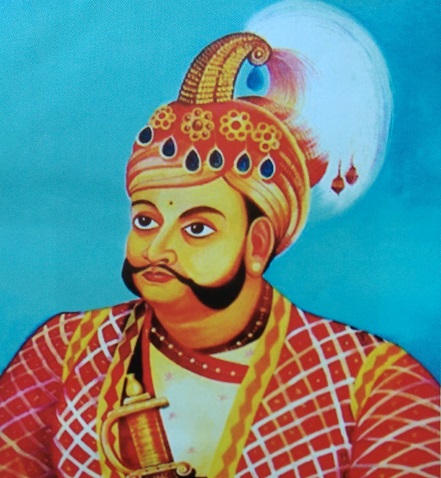
Eraniel Palace
A history nearing extinction.

A history nearing extinction.
On the panoramic lower plains embracing the Western Ghats, on its western side, extending towards the seas, about 11 km from Colachel, on its south-north, almost at 8’.11 x 77’. 20 degrees there situates an ancient premier princely palace called Eraniel. The origin of the name Eraniel is shrouded in mystery. It is buried under the sands of time. It may be a corruption of Ranasimha-nallur. Rana Simhan was one of the earlier kings of Venadu. The place was known in different names at different times including Rena Simha Nallur. The present palace is of later period with modern tiled roofs, now in dilapidated, rugged, mutilated, stoned, betrayed and beaten conditions. This palace was called the Thai Kottaram or Mother Palace for the Kings of Venadu / Travancore.
Eraniel was the centre of power for the great Mitakshara Patriarchal emperors of the famous Perumals of 8th century, or even of the 1st century AD Perumals. With several higher centres of learning around, it remained an important cultural centre for the great Chera emperors of Karuur and Kodungallur. Parthipasekara puram Uzhakudivilai (Munchirai), Chitharal, etc., were the centres of learning, or Universities, known even to the Chinese.
Like the Pandya dynasty, Chera dynasty is one of the earliest dynasties of India. The Chera King had fed food to the entire armies of the Mahabharata war, (BC 3102 ). There is a museum near Sri Padmanabaswamy temple, Trivandrum. In that museum is preserved a list of Kings. The list is divided into: Part-I, Puranic, and Part-II, Historical. In the Puranic, it starts with King, Manuvaivaswata, a Dravidian King. There are many branches in them. In the part II, it starts with Ayyanatikal Tiruvati (c 870-910 AD), and it gives 56 lines of kings ending with, Rama Varma XIV (Chitirai Tirunal -1931-1991AD).
Ref. The Forgotten Dynasty Behind the Biggest Hoards of India
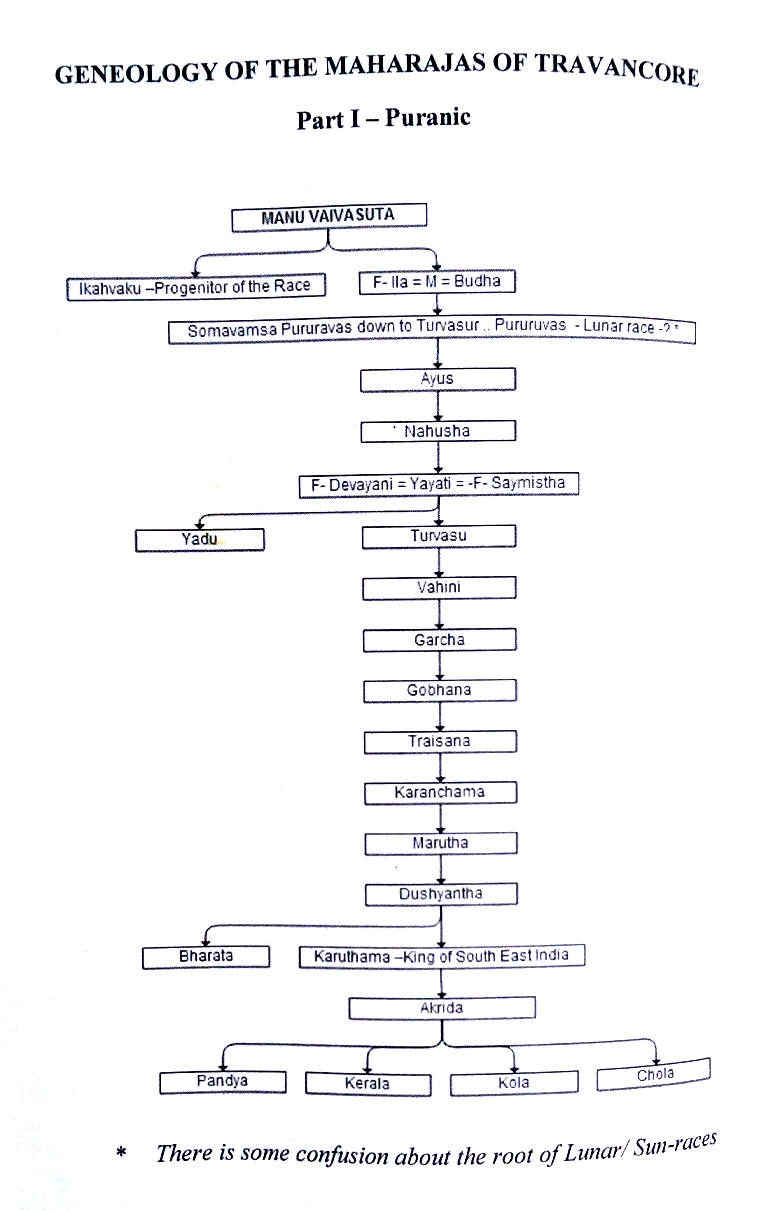
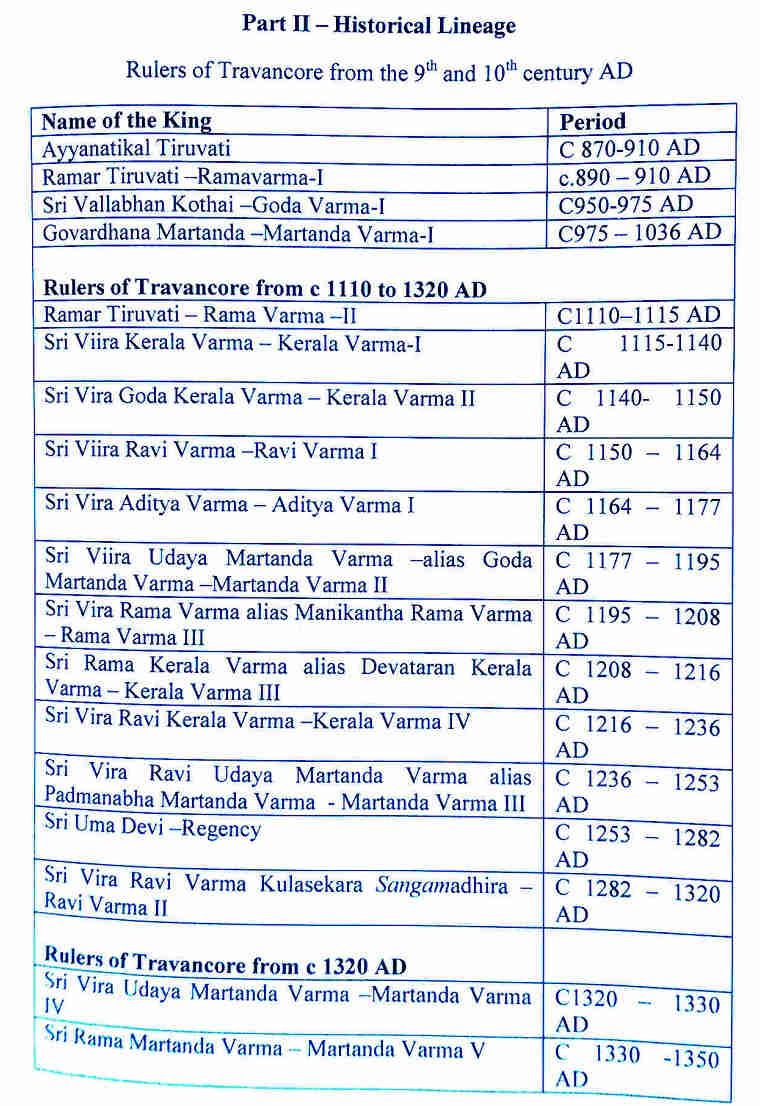
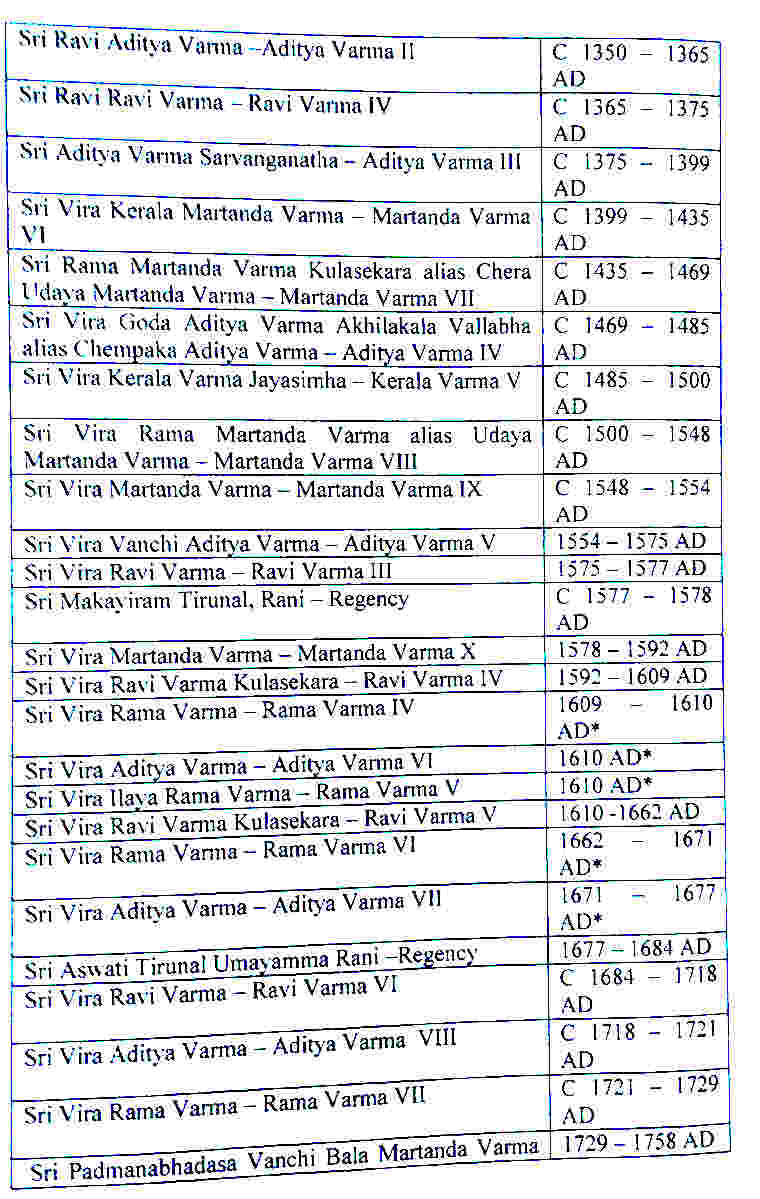
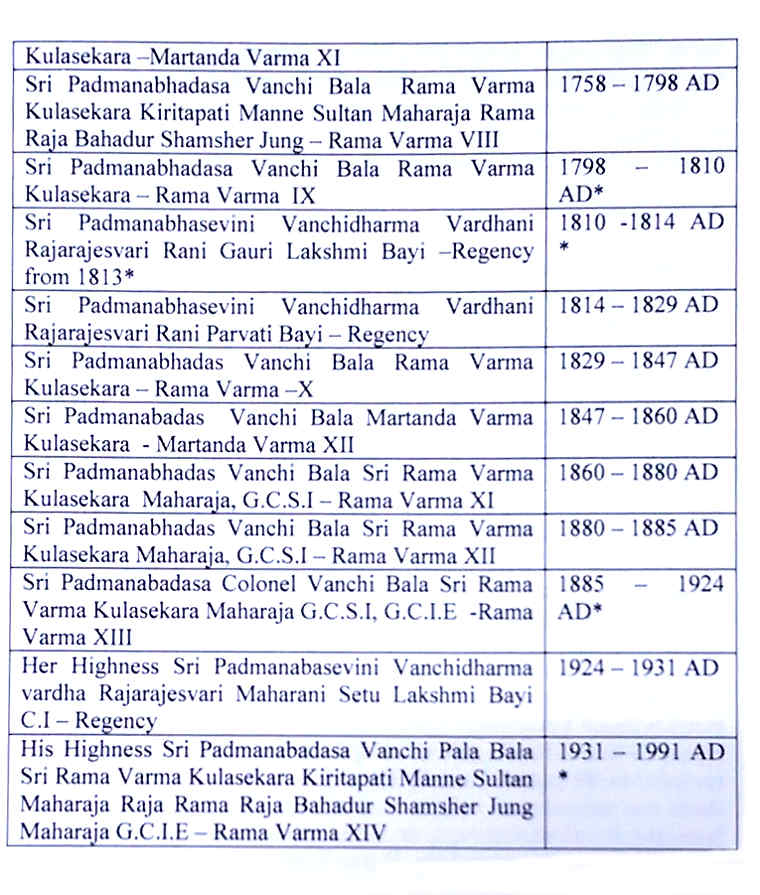
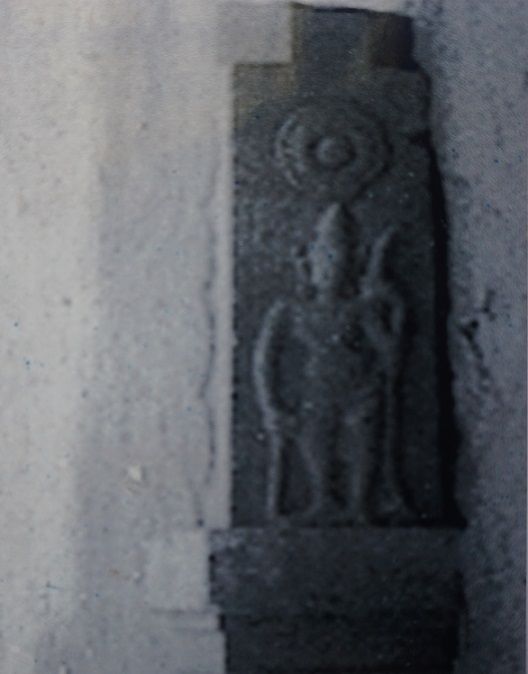
An analysis of the list confirms that there is an amalgamation of dynasties/families, like Aten, Aye, Uthayen, Porraiyan, Yadava, Villava, Vanava, Kothai, Perumal , Kulasekara, Ayyanadigal, Goda Varman, etc, and the ‘birth-star oriented kings (like Moolam Tirunal, Chitirai Tirunal, etc,) are seen only in a very later stage, with Brahmanic influence. For coronation, they used the traditional decorated palm-leaf crown, except in the last eras of 19 th or 20th century. The selection or nomination for King was done, probably in a way of rotation, the “Mootha” being nominated for the post of senior position of overall emperor, like ‘Perumal’. There was Ettu Turam Nadakkal in charge of the affairs. From around 1661 AD, there seems to have originated the section of Ettu Viittil Pillamar who had turned out to be the royal rebels or traitors in the long run.
In the middle and later stages, there seems to have had 39 branches in the royal dynasty of Travancore. Almost the same type is observed all over India. Rajasthan had only 36 branches. “Sanan” is one among them. The original 39 branches of royal dynasty in Venadu is reduced to 18, and as 8, and finally settled to nine. According to 1901 Census Report of India, it is fixed to 9 branches. On official records, the Royal Clan of Ruling Dynasty of Travancore, namely, Trippapur (Thirupappu) comes under the main head of “Channan (Santor” in Nattan (Nadar=Nadalwar) division, as shown below:
| Caste | Sub Division | Sub Division Name | Strength |
|---|---|---|---|
| Channan | 39 | 1 Ittanat*(Ediga-Date-palm) | 1211 |
| 2. Illam (Poojari) | 4,405 | ||
| 3. Kana (Gana) 1,771 | 1,771 | ||
| 4. Karukumattai (Talwar) 4,813 | 4,813 | ||
| 5. Kavara (Kavithi) | 20,786 | ||
| 6. Kiriyam | 22,596 | ||
| 7. (Mootha / Perumal)* | 5,686 | ||
| 8. Nattan (Naden)* | 2,791 | ||
| 9. Trippapur*(Ruling Clan) | 6,251 |
It is to be noted here that the word “Channan” is a corruption of original Tamil word “Santan” meaning ‘Elite’ or ‘Sane Judge’.The word “Ittanat” is allied to Eetha-Panai (Date-Palm), the Symbol of Ediga Nadans of Vijayanagara Empire.The word “Karukkumattai” is corruption of 'Karukku Pattayar' (sharp-sworded) equivalent to northern, 'Talwar'
The Travancore State Manual written by T.K.Velu Pillai records that the Chera Dynasty is existent from the times of “Phoenicians” and beyond the times of ‘Mahabharata’. The great Phoenicians are mentioned in Bible in 778 BC. But their existence was much beyond the Christian Era. The Phoenicians are a great warrior class who excelled themselves in international trade. They were “Toddy Tappers” from Southern Kerala, and were great “Sailors of Inter-Continental Trade”. They were called by different names like “Palm-Asians”; Panesiyer, “Minoans”; Eutrascans; Panayer, Nanadesis, Ezhunootruvar, Munnootruvar, Panai-yeriyer, Pathinenn Vishayar, etc. They parted culture to Ionians, Greeks, the Chaldeans, Hittites and the Egyptians. They established the ‘Hittite Empire, and also had ruled ‘Egypt’ as “IX Marakara Dynasty” in c.2250 BC. In c.BC.2220, one branch of them came back to India, established in Goa, and founded the great “Chantor Puri” = City of Santors. The model of that city is available in the Goa Museum established by the Portuguese.
The greater ‘Thamizhagam’ (Tamil country) had twelve divisions with a single language of Tamil for the entire country. In ancient times, these were of the early Jain-patterns. ‘Eraniya Mutrathu Perum Kausikanar’, the great Jain Saint of Sangam age reminds the same. Founded by the Pandyas, it is equally claimed and even ruled by the Cheras and, at times, by the Cholas also, who were from the same stocks of ‘kindred’ groups of brothers. Sometimes they quarreled and made great wars too.
The invasions from the Aryans, Moguls, British, French, Portuguese, etc., have scattered and buried the history of Eraniel. Of late, we know about the Peasants movement against the ruling King, led by Dalawa Velu Thampi (1799), the disappearance of Perumals (repeatedly), disappearance of the Thiruvati of Thesinga Nadu, lastly the criminal conspiracy of ‘oozing out’ of the Nadalwar King Udaya Martanda Kulasekara Perumal (Bala Rama Varma IX) from the palace, through the underground tunnel to his death bed in 1810AD, etc, are known to us (Ref. Forgotten Dynasty…/ Eranuel Thai Kottaram).
The later system of ‘Adoption’ to the royal family has clouded and buried several historical truths resulting in many dynastical gimmicks. In the end, the descendants of the ‘Perumal Family’ had formed a “Trust” namely: “Cheraman Perumal Memorial Family Trust: (Reg.127/2008)” by its dynastical heir apparent, Sri Jagadish Ayya, in 2008 , and the Court Case are pending at Nagercoil (Ref. Sons of the Soil…). At present the Trust is headed by Sri John Rose and is represented by Mr. C.G.Godwin Jose.
A. Chithambaranar, counting on the period of Eraniyen, son of Thakkan, attributes 3000 BC, as the age of Eraniyen and thereby to Eraniel. Making reference to the ancestors of the Nadalwars, the great Phoenicians of yonder years, it can go much beyond 10000 years or more. The reference to “Eraniya Mutrathu Perum Kausikanar” referred to in the Tamil Sangam literature , mentioning the great Jain Saint, it can be attributed at least to the 1st century AD, or little more than that. It was a Jain saint who became a victim of the scuffle between the Jains and the new Hindu activists in the 8th century AD when 8000 Jains had been sent to the gallows on a single day. This incident indicates to the level of burial of history.
These kings are from the root of Chera, Chola, Pandya as brothers. In this context, the exposure of the “Narasimha Maddom” in the secret chambers of Sri Padmanabaswamy Temple, Trivandrum also is worth re-calling, for its connection with Eraniel. Hence the period of Eraniel can be assessed as in between 1st century AD and 3000 BC, or still more. To pin point its exact antiquity, more research is required.
Elamkulam Kunjan Pillai, one of the sensible historians of Kerala writes that the Perumals were mostly emperors who were patriarchal. The Kulasekharas and Perumals were from the same root of political pedigree. But, lots of confusions are created by historians through the Sanskritic volumes of stories and ‘so called agama grandhas’ in mixed languages created between 7th and 12th century AD.
In the middle of 17th century AD, there was an infiltration from the Sanskritic group to corrupt Tamil and a new language was formed in the State. It was Malayalam with lots of admixture of Sanskrit and ‘Manipravalam’ words injected to original Tamil, the new language was formed. This new linguistic system introduced in the country, had resulted in incomplete and erroneous record-keeping in the country. The 30000 and more palm-leaf bundles found in the Chambers of Sri Padmanabhaswamy Temple, are not yet verified and brought to light. A truck loads of huge historical, Revenue and dynastical land records sent from Kerala to Kanyakumari in 1956, have been mutilated, desolated and misguided by govt. itself. Hence a great loss of history had occurred to the land. In order to find the real history of Tamils and the Eraniel Palace, we have to depend upon the scattered information from foreign travellers and other sources of random literature and available archaeological information and scattered writings. One of such writings points out: Eraniyen was the grandson of Thakkan. His brother was Eraniyakkan. Prahalathan was the son of Eraniyan. The descendants came from them were Maa-Bali, Sakuni, Poothanatha Naban, Mahavagu, Pulathiyan, Karthavirarjunan, Vibishanan, Ravanan, Kuberan, Mathu-vala Singan, Sisupalan, Hamsan, Jarasandhan, etc. Hence it is assumed that “Eraniyan” after whom the place name of ‘Eraniel’ is formed has an antiquity of around 3000 BC…” (A. Chithambaranar, Cherar Varalaru, p,12-13.)
Referring to Ptolemy, V.S.V Raghavan says that ‘Thiru-Aten-Code’ was an early capital of Thamilagam where, in the 1st century BC, or much earlier, the great Tolkappiyam was formulated. “There is a place called ‘Thackalai’and the three important places around it are : 1. Eraniel, 2. Kotha-Mangalam, 3. Thiruvithamcode. Among these, the first, Eraniel is the most important one” (Ptolemy, p.319).
One inscription dated 989 AD, found at Thirunandikarai, says of Erniyel, being captured by Rajaraja Chola-I, along with some other territories. There is another inscription by Umayamma Rani, dated 1682 AD, on opening a new bazaar at Eraniel, which is termed as “Rensinga-nallur”. Another inscription dated 1754 AD (ME.929) says of Eranieyl as Renasinganallur, mentions some recovery of lands favour of a temple. One Parthivapurm inscription also mentions about Eraniel, that one silver image being offered to the temple of partipasekarapuram, by Pallavarayan alias Sankaran Irana Singan. Another inscription of 1724 says of some compensation made for the damages done by troops on some temple properties around Ithankadu, and Suchindrum etc. It is observed that Eraniel has been linked up with Quilon, Kodungallur, Mahodayapuram and the Cheraman Perumals.
Lots of history has been lost. But, S.Ramanatha Iyyer gives some information on Perumals, connecting them with the ruler of Travancore in 1758-1798. (Dharmaraja period). This helps us to connect with his descendant, Udya Martanda Kulasekara Perumal (1798-1810) who was poisoned and killed by a combination of enemy groups, with the help of the British. This poisoned King of Travancore was the great grandfather of Ponnanintha Perumal (Ponnanintha Karuppan), and Jagadish Ayya. In the Revenue Records of the Village, it is in their names that the Palace and Puliyurkurchi Fort, etc., are enlisted with. S. Ramanatha Ayyar says:
“It will be of interest to give here a short account of the life of the royal Saint Cheraman Perumal, because of his connection with the ancient Chera House and King, Rama Varma of Travancore (1758-1798) mentions him as an ancestor of his dynasty… It mentions of king Senko-Porraiyen, the overlord of Malainadu. (“Porraiyen” kings are ‘Peace-loving’, of the Jain pattern). This king becomes a big Saint and disappears…”
This part of History corelates well with the history narrated by the decendents of Udhaya Marthantda Kulasekara Perumal (Rama Varma IX) .
Eraniel was an important industrial centre of the South Travancore during the Royal periods. Its whole area comprised of 12.2 square kms. The Rail way line almost touches the spot. We have now got many records which confirm that Eraniel was the earlier capital of Venadu. (NB. But, those records were not released). An old palace is still standing there in a bad condition. It was known as ‘ Theke Thevancheriyil Ko-yikal’. Today it is known as ‘Eraniel Kottaram’. Agriculture, weaving and mass production of Karuppukatty (palm-jaggary) were the important industries here. (From the book Progress of Travancore Under H.H.Sreemoolam Tirunal, by Ulloor S.Parameswara Aiyer, we understand that the one third revenue of the State was from the palm-products and it was stopped under the biased political instigation of K.K.Kuruvila, B.C.E, and party, with the help of the British, under the ‘Akbari Bill Legislation’ of ME.1073=1898 AD, bringing an untouchability to toddy- an action ‘politically and socially motivated’ ) .
The Mathilagam Records say that the Viira Marthanda Varma of Kiizh perrur visited the ‘Eraniyanka-nallur Palace’ and on the same occasion, the Mootha Thiruvati of Thesinga Nadu, Sri Viira Kerala Varma was staying there, but had disappeared (mudinjaruli) from there (any political conspiracy in the disappearance? )
On times, this palace was under the Aye kings and then became a part of the Cheras. But, the Pandyas and Cholas have also kept their claim over it. It was subjected for the invasion of Vijayanagara empire also. Eraniel Palace worked as an out-post in the war against the Dutch, in AD 1741 when its captain was captured by the lieutenant and relative of King Marthanda Varma, warrior Ananda Padmanabhan Nadar. For his great bravery, the King, in 1748, had given a Copper-plate and granted 144400 acres of land. But, this part of history also is being tried to be hijacked (Ref. Anatomy of a Folklore; Kanyakumari Aspects and Architects).
A Matilagam Record of 1459 AD, says that these ‘Nadalwars’ known as ‘ Santors’ (Channans ) were the own relatives (kindred) of the rulers of Venadu, Sri Vira Marthanda Varma, and these relations of the King, namely, “Ayyappan Kothai and Raman Kothai” were the in-charge of the great ‘Treasury of Padmanabaswamy Temple’ and they also were in charge of the sacred duties of ‘Taking Care of the Deity, Sri Padmanabha’. But, history shows that the same community of Santors were thrown out of temple after 1810 AD, with the death of their king, and they had to fight for a half century to enter in it.
The Travancore State Manual written by Nagam Aiya mentions that out of 1,55,864 Nadalwars, 43,044 Nadalwars were staying in and around Eraniel during 1940-s The above explained facts throw much light on the darkened history of Eraniel. Toddy=Palm-Juice =“Amrit”, one of the ‘Royal Foods’ of ancient India is treated as untouchable in 1887. Phoenicians, the Toddy Tappers, one of the earliest Civilized Races of the World, who had established many Empires, even outside of India, are treated as “Untouchables” due to the change of language, People, and a system of prejudiced Culture.

In the year, 1998, two articles were written in a Tamil magazine “Thadayankal” (Evidences). They gave the picture of the falling palace with its short history, its connection with ‘Nadalwars’ and one of the descendants of the great Perumals, the late grandson of King ‘Udaya Martanda Kulasekara Perumal (1798-1810). In 2007, this subject was published in a book, Kanyakumari Aspects and Architects, printing an article, “Two Palaces”, which tells about Eraniel Palace. It mentioned about the present heirs of the palace. In later researches conducted, it was confirmed that this King, Udaya Martanda Kulasekara Perumal (Bala Rama Varma IX) was poisoned and killed by a combination of enemies, with the help of the British, in the year, 1810. It was also found out that the Palace, Fort, and huge properties were in the names of the heirs, Ponnanintha Perumal (Ponnanintha Karupan, Niithi Udayan, John Jagadish Ayya…etc, till 2006. It is presumed that the claim of confiscation of the Eraniel palace and the fort by the govt., is purposely done, illegally, to avert historical links of evidences against Nadars, and thereby, against history itself.
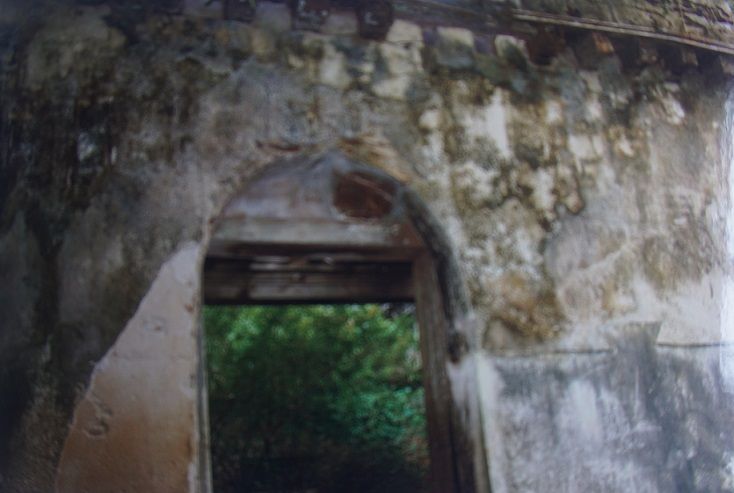
It was also found that a portion of the palace area was allotted to set up a school. But, in 2006, when the district collector wanted to construct a hostel for girl-students, in the premises, the matter was objected to by the INTACH Organization that the area was a private and part of the palace. Consequently, although the foundations had been dug, the collector had to cancel his project, and the work abandoned on orders dated 13.9.2006/ 5.10.2006. The question remains, how can the School or the Hindu Religious Charitable Endowments, convert an area of a private party? That too, a place of historical value? Is it not a denial of history? These area under R/S.NO.487 been already allotted to the ancestors of Jagadish Ayya, along with other properties coming under the 7th division of ‘Colachel Pakuthy’ as their Royal Share? There are, it seems to be, lots of political gimmicks in such historical matters.
The connection of “Nadalwars” with the Eraniel Palace and the Ruling dynasties of Venadu/ Travancore or Kerala are well established from the following Evidences:
"From the References made in the Travancore State Manual about “Nadalwars”
Matilakom Records, Curuna NO.1719., Olas, 95-96. "
"The Title of “Nadalwan” to II Rajendra Chola, in an ‘Historical Stone Inscription’ of 1055 AD. "
"Census Report of India, 1901, that Travancore Ruling Clan of “Trippapur” is a branch of Nattan or Channan or ‘Nadalwar’."
The “Villava Icon” found in the fallen Pillar of Eraniel Palace.
The Chera Chola, Pandya ‘Unity emblem’ found in temple at Chandragiri of Andhra Pradesh.
Remains of the Iconic pillar depiction of Sri Rama and the Seven Palm-trees found in a temple in Andhrapradesh, partly destroyed by the French.
The Huge Copper-plate issued by Nadalwar kings to Brahmins as huge gifts of landed properties.
Stone Inscription of Oneness of Chera, Chola, Pandyas
Kodungallur Pattayam, issued by Vanchi Marthandan Thampuran and Dewan Madhav Rao.
The title “Sri Vallabha” for Nadalwar in Stone-Inscription.
Title “Panayan” is for Nadalwar as in Thanchai Peru Udayar Temple
Social record of Deeds: Nadalwars as “Kshatriyas”
Historical records are pouring in favour of ‘Nadalwars’ to prove their link not only with Eraniel palace, but also with many dynastic groups of India. A book titled :The Dravidian Lineages- the Nadars through the Ages reveals more than 250 branches of these Nadalwars, extending to North, East, West and even beyond India. The Ediga Nadans who had 360 trade points all over the world is one among them. Their trade symbol (till 1807) the Date-Palm with Tiger is being used as the symbol of the Reserve Bank of India, even today, being handed over by East India Company, since 1947.
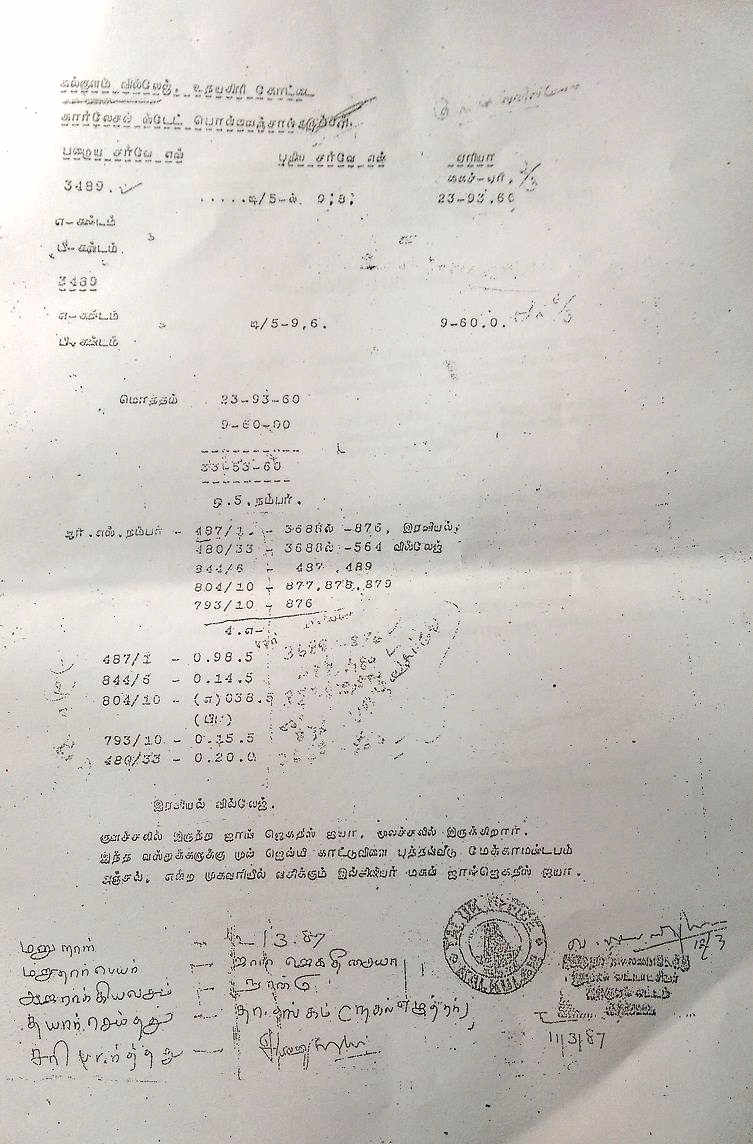
After the calamities following the assasination of Anantha Padmanabhan Nadar in 1750, and the death of 'Marthanda Varma the Great' in 1758, and his offering the country to Sri. Padmanabha, the Royal Family has divided properties for each family in which the portion under the 7th division of Colachel paghuthi, has come to the share of the decendents of Rama Varma IX (Udhaya Marthanda Kulasekara Perumal). These Areas comprising of
(1) Udhayagiri Fort (Puliyurkurichi Kottai) Old Survey No. 3489, with 23.9366 Hectares of land and another 9.60 Hectares.
(2) New R.S Number 487/1 and in its sub divisions a total of 4.5 Hectares including the Eraniel Palace coming to the share of Sri. Ponananjan Karupan (Pon Anintha Perumal) and to his great grandson Sir John Jagadish Aiya, the decendents of Rama Varma IX who was poisoned and Killed.
These properties detailed above are marked in the Kalkulam Village office, acknowledged by Tasildar with the Govt. seal of Kalkulam Taluk Office in Kanyakumari Dist. dated 11-3-1987.
In these, the Udhayagiri Kottai (Fort) has been now being Utilized unilaterily as a tourist center by the Tamil govt. from recent times.